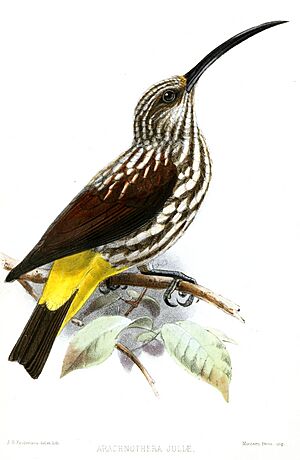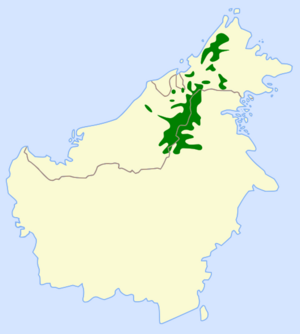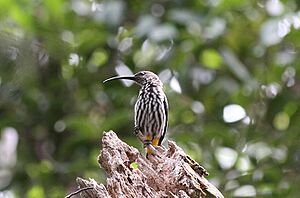Whitehead's spiderhunter facts for kids
Quick facts for kids Whitehead's spiderhunter |
|
|---|---|
 |
|
| Illustration of Whitehead's spiderhunter by John Gerrard Keulemans | |
| Conservation status | |
| Scientific classification | |
| Genus: |
Arachnothera
|
| Species: |
juliae
|
 |
|
The Whitehead's spiderhunter (Arachnothera juliae) is a special type of bird called a spiderhunter. It belongs to the sunbird and spiderhunter family known as Nectariniidae. This bird lives only in Borneo, an island in Southeast Asia. You can find it in the mountain ranges in the north-central part of Borneo. It likes to live in forests on hills and mountains, from about 930 to 3,000 meters (3,050 to 9,840 feet) high.
This spiderhunter is quite large and easy to spot. It's mostly brown with lots of whitish streaks all over its body. Its belly and the feathers under its tail are bright yellow. Both male and female birds look similar, but males are a bit bigger. Males are about 16.5–18 cm (6.5–7.1 in) long, while females are about 15.5–16.5 cm (6.1–6.5 in) long. We don't know what the young birds look like yet.
Whitehead's spiderhunters eat small arthropods (like insects and spiders), berries, and nectar from flowers. They usually look for food alone, in pairs, or in small groups of up to five birds. They build unique nests lined with bark inside hollows they dig out of moss or roots. They lay two eggs, and the parents feed the chicks berries and arthropods. This bird is currently listed as "least concern" by the International Union for Conservation of Nature, meaning it's not in immediate danger. However, its population is slowly decreasing because its forest home is being destroyed.
Contents
What is a Whitehead's Spiderhunter?
In 1887, a British bird expert named Richard Bowdler Sharpe officially described the Whitehead's spiderhunter. He named it Arachnothera juliae. He found specimens (samples) of this bird on Mount Kinabalu in Borneo.
The name of the genus (a group of similar species) Arachnothera comes from ancient Greek words. Arakhnēs means "spider," and thēras means "hunter." So, it literally means "spider hunter"! The specific name juliae was given to honor Julia Charlotte Sophia, who was the wife of another bird expert, Arthur Hay, 9th Marquess of Tweeddale. The common name, Whitehead's spiderhunter, honors John Whitehead, the British explorer who collected the first birds.
Whitehead's spiderhunter is one of 147 different species in the sunbird and spiderhunter family, Nectariniidae. Within this family, it's one of 13 species in the Arachnothera genus. Scientists have studied its family tree and found that it is most closely related to the yellow-eared and naked-faced spiderhunters.
How to Identify a Whitehead's Spiderhunter
This bird is a large and special spiderhunter. Males are about 16.5–18 cm (6.5–7.1 in) long, and females are a bit smaller at 15.5–16.5 cm (6.1–6.5 in).
It's mostly brown with many streaks on its head and body. The top of its head has buffy-white streaks. Its neck and back have thin white streaks. The throat has fine brownish-white streaks, and the rest of its underside has wide white streaks. The feathers on its belly and under its tail are bright yellow. Its eyes are brown, and its legs and beak are black. Both male and female birds look alike. We don't know what the young birds look like.
Whitehead's spiderhunters have very unique calls and songs. They make high-pitched, squeaky sounds. Some of their calls include a wheezy "wee-chit," where the first note goes up and the second goes down. They also make complex series of nasal and wheezy "wit-wit-wit-wt’wt’wt’weehee" sounds, and a "teeh-teeh-wee" where the "wee" goes up in pitch. Other calls are "see-wee see-wee," "swee-eee-eee," "tee-tee-swee-ee," long twittering sounds, and loud shrieks when flying or sitting.
Where Whitehead's Spiderhunters Live
Whitehead's spiderhunter lives only in Borneo. You can find it in the mountain ranges in the north-central part of the island. This includes areas from Mount Kinabalu to the Dulit Range and Kayan Mentarang.
It lives in different types of forests:
- Hill dipterocarp forest (a type of rainforest).
- Primary (old, untouched) and secondary (regrowing) montane forest (mountain forests).
- The edges of forests.
They live at high elevations, from about 930 to 3,000 meters (3,050 to 9,840 feet) above sea level.
Life and Habits of the Spiderhunter
This bird is quite calm and has a generation length of about 4.2 years. This means it takes about 4.2 years for a new generation of birds to grow up and start having their own chicks.
What Whitehead's Spiderhunters Eat
Whitehead's spiderhunters eat small arthropods (like spiders and insects), berries, and nectar from flowers. They usually look for food alone, in pairs, or in small groups of up to five birds. Sometimes, they even join other bird species that are foraging together.
They mostly search for food high up in the canopy (the top layer of the forest trees). However, they will sometimes come lower down at the edges of the forest. They look for food among the leaves, especially in clumps of epiphytes (plants that grow on other plants) high in the trees. They have also been seen poking their long beaks into Rhododendron flowers to get nectar.
Reproduction and Nests
Whitehead's spiderhunters breed from March to at least August. Male birds with larger testes (which means they are ready to breed) have been found in June and November.
Their nests are like bowls, lined with thin, stringy bark. They build these nests inside hollows that they dig out of natural clumps of moss, other plants, and roots. These clumps hang from trees about 10–19 meters (33–62 feet) off the ground. The spiderhunters make the hollows by removing plants from the clumps. The nest bowls are about 7 cm (2.8 in) across and 4 cm (1.6 in) deep. The entrance to the hollow is about 5 cm (2.0 in) wide.
This type of nest is very special and unique among all spiderhunters. Only the closely related yellow-eared and naked-faced spiderhunters build similar nests. Other spiderhunters usually make nests from leaves, lined with soft material, and attach them to the underside of banana leaves or palm fronds.
Whitehead's spiderhunters usually lay two eggs. The parents feed the young chicks berries and arthropods.
How Many Whitehead's Spiderhunters Are There?
The International Union for Conservation of Nature lists Whitehead's spiderhunter as a species of "least concern." This means that it has a fairly large area where it lives, its population is big enough, and it's not facing a big drop in numbers right now.
It was once thought to be "near-threatened," meaning it was close to being at risk. Scientists believe its population is currently decreasing because its forest home is being destroyed. However, it does live in some protected areas, like Kinabalu Park and Rafflesia Forest Reserve, which helps protect it.



